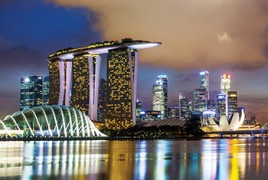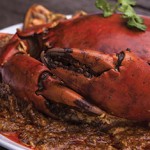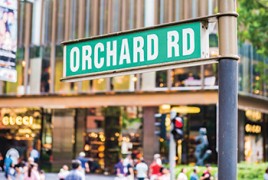The Big Red Dot: a guide to Singapore
 Sibos delegates are arriving in the city state of Singapore at a turning point in its history: 2015 marks the 50th anniversary of independence from Malaysia, but also the death of Lee Kuan Yew – prime minister for 31 of those 50 years and architect of modern Singapore.
Sibos delegates are arriving in the city state of Singapore at a turning point in its history: 2015 marks the 50th anniversary of independence from Malaysia, but also the death of Lee Kuan Yew – prime minister for 31 of those 50 years and architect of modern Singapore.
Once dismissed as “the little red dot” on the map, under Lee’s guidance Singapore’s economic growth was phenomenal, particularly as the country has no natural resources. In those 50 years, Singapore transformed itself into a financial powerhouse. In 2014 the World Bank ranked it seventh in terms of GDP per capita, just behind Sweden and ahead of the US.
But this was achieved at some cost: Lee’s approach was a form of benign dictatorship; though not so benign for political opponents, or journalists critical of government policy.
Singapore is also famous for its intolerance of anti-social behaviour; the word Draconian comes up a lot, with a wide-ranging definition of what constitutes anti-social: dropping litter and cigarette ends? Yes. Spitting on the pavement? Chewing gum? Failure to dispose of used gum properly is certainly antisocial as any Londoner or New Yorker can tell you. But selling chewing gum? Wait a minute …
Punishment for some offences involves public caning. In March this year Reuters reported that two Germans were sentenced to three strokes of the cane and nine months in jail for spray-painting graffiti on a train carriage.
“Vandalism and over-staying by foreigners are offences that can be punished by caning along with other crimes like kidnapping, robbery, drug abuse and sexual abuse,” reported Reuters. “According to the US State Department, 2,203 caning sentences were carried out in 2012, including 1070 foreigners caned for committing immigration offences.”
So, a prosperous, clean and safe place to visit, if a tad cranky? What’s there to do (in a socially acceptable manner) outside the conference centre? Plenty.
Food
For Singaporeans, shopping and eating are full-time leisure activities. Geographic and cultural influences from across South East Asia and colonial hangovers (see Raffles Hotel Bar) have created one of the world’s great food destinations.
 Ask anyone who’s been there and even some of those who haven’t and they’ll tell you that you have to try chilli crab (left). If you like chillies and crab, then you probably should: it’s essentially crab in a chilli sauce. Usually a whole crab.
Ask anyone who’s been there and even some of those who haven’t and they’ll tell you that you have to try chilli crab (left). If you like chillies and crab, then you probably should: it’s essentially crab in a chilli sauce. Usually a whole crab.
According to the cookery website www.singaporelocalfavourites.com, it was invented in 1950 at the Palm Beach Seafood Restaurant, so if you’re into food heritage, that’s a pilgrimage that you can make. No longer at its original location, it can be found at One Fullerton Road (+65 6336 8118), as part of the Fullerton Hotel. The restaurant serves a wide range of dishes other than chilli crab, including the teasingly named “Uniquely Singapore Fish Soup” for which you’ll need eight to ten diners or be uniquely hungry. Not for the squeamish is live lobster sashimi and they also serve shark fin soup, of which many will disapprove. Pilgrimage or protest? The choice is yours.
Time Out Singapore recommends Hua Yu Wee Seafood at 462 Upper East Coast Road (+65 64429313).
You’ll be told that fish head curry is unique to Singapore and there’s a good chance that you’ll be glad to hear it, but you can get it in Malay restaurants all over the world. It is a good, if rather un-photogenic, example of how Singapore mixes food cultures, in this case the curry spices of India with the ‘if it moves, eat it’ approach of the Chinese. It was apparently created by an Indian restaurant in the 1960s to cater for its Chinese clientele. The equivalent of chop suey in the US or chicken tikka masala in the UK, then.
From our ex-correspondent
Malcolm Borthwick from BNY Mellon’s corporate communications in London spent three years in Singapore as a BBC correspondent. Here he outlines his idea of a good way to spend a day when he returns to the city
I’d start the day by taking the cable car over to Sentosa Golf Club (+65 6275 0022) for a round of golf. You get a great view looking back from Sentosa Island to the city. It’s a championship golf course where they host the Singapore Open.
Also on Sentosa is Fort Siloso which has many displays related to the British surrender to the Japanese during World War II, underground tunnels etc.
Afternoon tea is a good idea too. A tough choice between Shangri-La Hotel (22 Orange Grove Road) and Raffles. Given the history and splendor of Raffles, I’d have to go for Raffles. Afternoon tea also gives you a chance to linger and take in the atmosphere.
A Singapore cliché is to have a Singapore sling in the long bar at Raffles Hotel, but it’s good fun and great to sit out on the veranda in big cane chairs.
I’ll need some exercise after this, so I’d go for a swim at the rooftop pool at the Fullerton Hotel.
I’d round off the day with some satay or skate wings with chilli at Lau Pa Sat (right, 18 Raffles Quay). It’s a hawker centre which has a beautiful cast-iron structure and clock tower. The frames were cast in Glasgow before being shipped to and assembled in Singapore.
The place to find it is in the Little India area, where plenty of the Indian restaurants will have it. The Muthu’s chain of curry houses are reckoned among the top (and they also do a fish head tandoori). There are Muthu’s at 138 Race Course Road (+65 6392 1722), 3 Temasek Boulevard in Suntec City Mall (+65 6835 7707) and Block 7 Dempsey Road (+65 6474 5128). Fish head curry also can be found at Banana Leaf Apolo (56 Race Course Road, +65 62938682). It also serves “the world’s best chana masala” according to Tony Freeman of Omgeo.
Little India will be abuzz with excitment in the lead up to the Deepavali (or Diwali) Festival on 10 November. Between late September and 9 November, a Deepavali Festival Village will be located in Little India, comprising an eclectic mix of stalls selling clothes, jewellery, gifts and food. Music concerts also will be held.
The other candidate for the title of Singapore’s National Dish is chicken rice. As such, you’ll find it everywhere, but there’s a concentration of stalls at the Maxwell Food Centre, which is in Chinatown at 1 Kadayanallur St. Of these, the stand-out has to be Tian Tian Hainanese Chicken Rice, which gets the number one vote of the official tourist website www.yoursingapore.com, Time Out Singapore, British potty-mouthed chef Gordon Ramsay and has featured on US chef Anthony Bourdain’s TV show No Reservations.
On the subject of celebrity chefs, Jason Atherton (who he? – Ed) has a triple presence here, with Pollen, which is at Gardens by the Bay at 18 Marina Gardens Drive (+65 6604 9988) and The Study at 49 Keong Saik Road (+65 6221 8338). Atherton also has a stake in tapas bar Esquina at 16 Jiak Chuan Road (+65 6222 1616). Atherton fans (still no idea who he is – Ed) will be surprised it’s not called Singapore Social, but many of the other hallmarks are here: the menu is divided into ‘Snacks, Soil, Sea, Land’ and the like and dishes have the multiple contrasting ingredients with unfamiliar name format familiar in his other ventures. ‘Wagyu beef intercostals with artichokes and romesco’, for instance: it’s some sort of upmarket beef rib with vegetables and sauce. At S$26 it has to be worth finding out. The same goes for ‘Sardines with Samfaina: Grilled zucchini, roasted bell pepper sorbet, eggplant caviar’ at S$16.
Like in the US city of Las Vegas, many of the large hotels in Singapore house clusters of celebrity chef restaurants. The Marina Bay Sands hotel at 10 Bayfront Avenue, for example, is packed with celeb chefs: Waku Ghin, run by legendary Japanese chef Tetsuya Wakuda, Bread Street Kitchen (Gordon Ramsay) and CUT (Wolfgang Puck). And judging by the hotel’s website, celebs attract celebs; English football star David Beckham appears to be a frequent guest.
Drinking
The Singapore Sling is a world-famous tipple, first concocted in a world-famous location, the Long Bar at Raffles Hotel (1 Beach Road), exactly 100 years ago this year. Daily News at Sibos does not recommend that anyone mark the centenary by trying to down 100 slings during Sibos. Call it the Sibos Singapore Sling Challenge if you like, we will have nothing to do with it.
To celebrate the centenary, the hotel is offering an hour-long Singapore Sling masterclass “where bartenders from the Long Bar will divulge the secret to making the perfect cocktail” for S$88 per person, with a minimum of 10 people. The basic ingredients (according to the International Bartenders’ Association) are gin, Cointreau, Benedictine, cherry brandy, Grenadine, pineapple juice, lime juice and Angostura bitters (is that all? – Ed). But across town bartenders are knocking out variations, homages and their ‘take’ on the classic.
The bar at Adrift (which is also at the Marina Bay Sands hotel) is recommended for sticking close to the original, while The Spiffy Dapper (2nd floor, 73 Amoy Street) adds Fernet Branca, Becherovka and absinthe to the mix.
Apart from the actual drink, the choice of location for many will involve the view. Many of the bars listed as the ‘best place to drink in Singapore’ are there because of their views. Lantern at the Fullerton Bay Hotel (80 Collyer Quay) isn’t high, but the view across Marina Bay and the Singapore skyline is pretty classic and will improve your selfie photographs no end.
Culture
The different neighbourhoods also give an insight into the different cultures that have come together. The Bras Basah.Bugis Precinct in the civic centre is where to go for museums, monuments and art. The area is home to the National Museum of Singapore at 93 Stamford Road, which will give you a good overview of the history of the country. Despite dating back to 1887 it is a modern museum featuring immersive audio-visual experiences and a constantly changing programme.
Permanent exhibitions include the Singapore History Gallery and Modern Colony, which charts the growth of Singapore up to the 1930s. The section titled We Built a Nation brings the story more up to date, describing the first ten years of independence and how Lee Kuan Yew (“and his team”) laid the foundations for modern Singapore.
Shopping
Bugis Street – still in Bras Basah.Bugis – is recommended for bargains among its 600 revamped shops.
 Orchard Road is claimed to be Asia’s most famous shopping street. Its 2.2 kilometre length features 22 malls and six department stores. Everything from high-end art galleries to craft stores to gourmet foods can be found alongside familiar names from the worlds of fashion, jewellery and lifestyle.
Orchard Road is claimed to be Asia’s most famous shopping street. Its 2.2 kilometre length features 22 malls and six department stores. Everything from high-end art galleries to craft stores to gourmet foods can be found alongside familiar names from the worlds of fashion, jewellery and lifestyle.
Getting around Singapore
Singapore’s mass rapid transit (MRT) system is extensive and easy to navigate. The (green) EW line runs more or less east/west and the (red) NS line runs more or less north/south.
Sibos delegates using the MRT will need to use the (blue) Downtown (DT) line to Bayfront, which is about 200 metres from the entrance to the convention centre. Other lines are the circle (CC) and North-east (NE).
Swift will be giving delegates EZ-Link contactless payment cards that can be used on the MRT, buses and the Light Rail Transport lines that serve outlying housing areas. You have to tap in and out when using it.
There is an MRT station at Changi airport, on the EW line. Getting from there to Bayfront involves changing once, should take about 50 minutes and cost S$1.87.
First-time visitors will remark on how clean the transit system is, which is a direct effect of Singapore’s intolerance of anti-social behaviour.
Taxis are relatively cheap and plentiful. As befits such an orderly place as Singapore, there are ranks at the hotels and points of interest. You can also hail them in the street, or there is Dial-A-Cab, a central booking number (+65 6342 5222) that will route your call to the nearest service. Uber operates in Singapore, but if you have the app, you already know that.
Apps
The excellent Citymapper navigation app covers all the transport options in Singapore. An alternative local app is gothere.sg. It’s only for iOS, and comes in two flavours: Lite and a S$2.99 full version. The Lite is probably enough for a short trip.
Other information
Singapore is just a little north of the equator, so temperatures are 31°C most of the year and around 25°C at night. Humidity is high, typically 70-90 per cent, particularly in the mornings. At this time of year short, heavy rain can be expected in the afternoon or early evening. Thunderstorms are frequent throughout the year.
Useful links










































